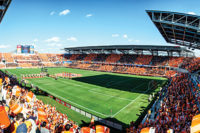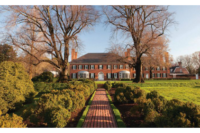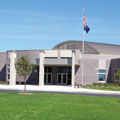
Mark Hanson, PhD, LEED AP, says he sometimes receives pushback from clients regarding sustainable building.
“People say they would like to do green, but it costs too much,” says Hanson, the director of sustainable services at Appleton, Wis.-based Hoffman LLC. “If that’s the reason people shy away from it, they should reconsider.”
Hoffman’s work on the 93,450-sq. ft. River Crest Elementary School in Hudson, Wis., paints an overwhelming argument for green design and construction.
Because of the integrated green design and construction-management approach, the 515-pupil school was delivered at 29% below the average cost for an elementary school in the Wisconsin, Illinois and Minnesota region.
“This is a clear case of a green project that does not need to cost more,” Hanson says. “It’s one of the terrific aspects.”
In addition to the monetary savings, the school’s green construction was recognized by theU.S. Green Building Council’s Leadership in Energy and Environment Design program. River Crest is the first LEED Gold-certified elementary school in Wisconsin and the second public elementary school in the country to be LEED Gold-certified under the LEED for Schools banner.
Pushing Green
Hoffman, the design and construction manager on this project, is no stranger to sustainability. The firm started doing green building projects in the 1990s.“We made some very deliberate choices to head in that direction,” Hanson says. “By 2001-2002 we were providing green projects for all of our clients whether the client chose to formally certify (LEED) or not. An increasing amount of clients put a high priority on green. The indoor air quality, the energy efficiency and the water savings are all paths we’re going down.”
River Crest officials are happy they chose to walk down that green path with Hoffman.
“It’s a beautiful school,” School District of Hudson Facilities and Ground CoordinatorJim Stejskalsays. “The planning and construction project was remarkably smooth and our partnership with our architect and the project management team was very successful. We are very pleased with the results of the project.”
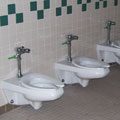
Restroom Rundown
Some students at River Crest might not be old enough to understand the water savings that occur in the school’s restrooms, but they are there and are significant. During the LEED certification process, the school was projected to enjoy a 47% total water savings over a standard baseline building.Fifty-one Sloan dual-flush toilets, along with 51 low-flow aerators contribute to the water conservation, as does a single Sloan solar-powered lav faucet. Other Chicago Faucets lavs feature 1.5-gpm flow rates.
The school utilizes 10 Sloan waterless urinals, which heavily factor into the savings because no water flows into the units. However, the waterless urinals must be maintained.
“The maintenance people need to be taught how to care for the waterless urinals,” saysJason Schnell, president of Mequon, Wis.-based Lubenow Gobster Dominiak & Associates, the plumbing system designer on the project. “It’s a learning curve. The number-one thing is keep the water out. Sometimes people put in leftover water or throw ice in the urinal. If water gets into the urinal, it can lose its trap seal. You are depleting the sealant and allowing sewer gas to get into the room.
“With a little bit of care and teaching, the urinals have strong possibilities. The cartridges are engineered to last for 7,000 uses and the cartridge is biodegradable. The manufacturer says the average savings in a normal building could be 40,000 gallons per unit, per year.”
The school also features several Bradley low-flow hand-washing stations outside the restrooms.
Water heating needs are taken care of by two A.O. Smith Cyclone sealed-combustion high-efficiency gas water heaters (95% efficiency).
“They are always maintaining temperature in the system circulating loop so the end user is not turning on the hot water and wasting water waiting for it to get hot,” Schnell says. “You’ve got hot water within a matter of seconds.”
Comfort For Students And Staff
Hanson notes a number of options were discussed regarding the school’s heating and cooling systems, including a variable-air-volume system.“We were evaluating whether it should be a central VAV system, a geothermal system or a system desired by the district featuring updated classroom ventilators,” he says. “The budget would not support ground-source heat pumps because of the high initial cost. We did our due diligence and the district decided on a hybrid approach with unit ventilators in each classroom and a centralized VAV system with energy recovery for the large common areas.
“For the classrooms, we’re bringing in outside air right at that ventilator. The ventilator provides either heating or cooling depending on the season. We’re marrying that outside air supply through unit ventilators with a centralized provision of either hot water or chilled water.”
The classroom ventilator choice, however, did present some challenges.
“What the client wanted, we hadn’t done in awhile,” Hanson says. “But we said, ‘Let’s go back and put the design together for that.’ It was an interesting challenge for the team. We came back to sort of what had been used in older designs and married it with new technology and came up with an effective approach. It was a good success story.”
Most of the classrooms in the school have the individual unit ventilators, while a few classrooms, Hanson notes, are part of the school’s central air-handling system. The heating and cooling system features a Trane chiller and Thermal Solutions sealed- combustion boilers (88% efficiency).
Several early childhood classrooms are equipped with radiant floor heating (tubing and manifold by Roth).
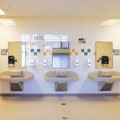
Translating Green Into Savings
Stejskal takes a different tact when quantifying the actual energy and water savings the school is realizing.He compares River Crest to the district’s Willow River elementary school, which is of similar size (both schools are just over 100,000 sq. ft.). Willow River underwent a total renovation in 2002-2003 and was updated to the latest industry standards at the time.
Over the last year’s billing cycle, River Crest used 9,000 gallons of water less than Willow River. Neither school has any type of irrigation system for lawn areas.
Stejskal says differences in enrollment paint an even clearer savings picture. River Crest realized superior water savings, despite having almost 100 more students in its school. River Crest also had building usage throughout the entire year, while Willow River experienced a period where no programs were scheduled in the building in the summer, meaning River Crest had more individuals demanding water for longer periods of time.
In terms of energy savings, over that last one-year period, River Crest used 14% less natural gas than Willow River. River Crest uses a system that introduces a much higher percentage of fresh air into the building, thus increasing air quality while still reducing natural gas usage compared to conventional systems.
River Crest used 23% less electricity on peak kwh than Willow Creek and 23% less off-peak kwh than its counterpart.
Current energy and water savings, coupled with the school being delivered well under budget, has turned out to be a win-win situation for River Crest.
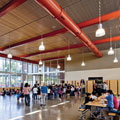
Covering All Bases
An Oregon school’s green focus is centered on long-term functionality.Rosedale Elementary School recently became the second school in Oregon to achieve LEED Gold status under the LEED for Schools system.
ButPAE Consulting EngineersPrincipalNick Collins, P.E., LEED AP, wants to make sure those green technologies that include a projected 37.5% in water savings, will be around for years to come.
“One of the things I really thought about was, because it is a school, there has to be a maintenance consideration,” says Collins, whose Portland, Ore.-based firm was the MEP engineer on the project. “Maintenance staffs at schools are always stretched thin. With this school, we achieved good energy and water efficiency, but we didn’t do anything magical or come up with any new systems. Everything together makes for a really efficient system that can be maintained so it remains efficient. It’s about getting the right stuff in there that is durable and maintenance can keep operating.”
One of the 74,100 sq.-ft.-school’s progressive and sustainable components is a radiant heating system housed in the commons area, which acts as both a lunchroom and gathering place for students. Uponor PEX tubing was installed in a radiant slab in the space. The tubing, which works off an Aerco boiler, runs down a corridor and into the commons area into the various zones. The tubing is wrapped in insulation to protect from heat loss.
“That area has a lot of good use of glass where a lot of daylight comes in, which makes the space even more open,” Collins explains. “The air is not as effective in a big, open space like that. We put in a radiant slab, which makes for a much more comfortable space in winter. It will keep the space really warm and students can sit in there on the floor and be comfortable. They won’t have that cold air coming off the windows and coming across the floor. There’s a lot of space there where students can interact. The system works really well.”
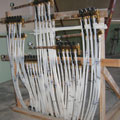
“We made sure we found the best selection of low-flow products,” Collins says. “You take care of everything you need by doing it judiciously so that you make sure you are getting the right stuff that performs well.”
Water heating is accomplished with Bradford White condensing water heaters with Armstrong pumps. Variable-flow Aerco boilers also contribute to the green footprint.
A 25,000-gallon tank by Xerxes stores stormwater onsite, which reduces runoff while storing the water for irrigation.
Rooftop air handlers with heat recovery by Aeon and DX-coils provide the heating and cooling for the school.
“We’re grabbing more air and recycling the hot air, which captures more of the heat that would otherwise go out,” notes Hillsboro School District Executive Project DirectorLoren Rogers.
Massive upgrades in insulation and a highly reflective white rooftop layer are other key movers in the school’s energy efficiency. The school is expected to realize an estimated annual energy savings of $26,800, while saving an estimated 450,000 gallons of water annually from EPA-rated fixtures. The school is projected to divert 4,010 tons of water per year.
“Most everybody cares about good air quality and energy and water savings and the things that go with that,” Collins says. “That’s what our focus was here.”

